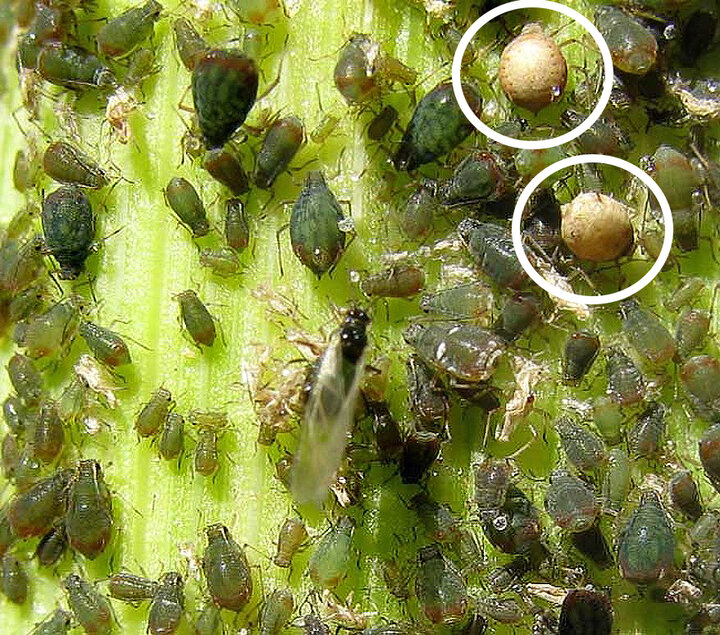Two types of aphids have been observed in corn over the last several weeks in west-central Nebraska. Corn leaf aphids (Figure 1) are bluish green in color with black legs and cornicles (the two “exhaust pipes” that stick out the end of an aphid’s abdomen). Bird cherry-oat aphids (Figure 2) are reddish green with legs and cornicles more closely matching their body color. A mixture of both species may be found in a single field.


Aphids are small, soft-bodied insects that feed on the juices of plants by inserting their sharp straw-like mouthparts into the plant tissues. Aphids are often found clustered in large groups that originated from just one or several females producing many offspring. Prior to tasseling, aphids may be found inside the whorl, on the developing tassel, and on upper leaves; later in the season, groups of aphids are often found on the husks of the developing ear, on the ear leaf, or directly on the stalk.
Aphid pressure is often the highest along field edges but will decrease as you move into the interior of the field. Therefore, when scouting, it is important to inspect plants from across the field, carefully examining at least 50 plants per field (for a ~132-acre pivot of corn) and recording how many plants are infested and their severity (are aphids completely covering the tassels or not?).
Crop Injury and Economic Thresholds
Before pollination: Aphids cause the greatest amount of injury while they are feeding within the whorl prior to tassel emergence. Aphid feeding can lead to wilting, curling and yellow discoloration of plant tissues. An excess number of aphids can also lead to the accumulation of honeydew (the sugary liquid waste excreted by aphids) and the growth of sooty mold, which can interfere with photosynthesis and pollination. Treatment may be needed if pollination is no more than half complete and more than half of the corn tassels are covered with aphids.
After pollination: Aphids are less likely to cause damage after pollination has been completed, unless they are very abundant. There are no research-based treatment thresholds for aphids in corn after pollination. However, treatment would be most likely to be economically beneficial if you have some or all of the following conditions:
- Corn was planted later in the season.
- Fields are under drought stress.
- High populations of aphids are present (80% or more of plants are infested).
- Aphid populations appear to be increasing over time.
- Leaves or tassels have been severely damaged (wilted, curled, yellowing).
- Presence of black sooty mold growing on aphid honeydew.
- Corn growth stage is not yet nearing dent.
- No signs of natural enemies contributing biological control (see next section).
If an application is warranted, see the Insect Management section of the Guide for Weed Management in Nebraska with Insecticide and Fungicide Information (EC 130) for insecticides to be used for aphid control in corn.
Biological Control of Aphids
Aphid populations can be greatly reduced by a range of predators, parasitoids and pathogens in the field. The most noticeable beneficial insects may be the predators: lady beetles, lacewings and minute pirate bugs are just some of the natural enemies that enjoy making a meal out of aphids (Figure 3).


Finally, aphids are susceptible to a pathogenic fungus that infects and kills them. Aphid survival can be favored by dry weather or the application of fungicides, which inhibits the activity of fungal pathogens.
